| [Top: John S. Allen's Home Page] [Up: Bicycling articles] [Previous] [Next: Tandem Crankset] |
|
| [Top: John S. Allen's Home Page] [Up: Bicycling articles] [Previous] [Next: Tandem Crankset] |
|
This article has been translated into Portuguese.
| A conventional bicycle is too large to fit conveniently in a car trunk. Bicycles are
prohibited as baggage on many bus and rail lines. Airlines charge large amounts of
money to transport bicycles. A folding bicycle can solve all of these problems. Folded
inside a duffel bag or carrying case, it passes anywhere as just another piece of luggage.
Some folding bicycles, designed to be as compact and light as possible, sacrifice riding qualities. Many don't even have enough seatpost extension to allow a grown man of average height to pedal efficiently. The frame is often flexible, and there may be little room for baggage. The Raleigh Twenty, on the other hand, is a workhorse. Its small wheels entail some slight increase in rolling resistance, but it has a normal riding position and good handling qualities. With the small rear wheel placed well behind the seat tube, the wheelbase is conventional, and a large amount of baggage can fit on top of the rear rack. |
Riding my Raleigh Twenty in 1979. My beard is mostly white
now,
but the Twenty and I still keep each other in good shape. It
has needed far more replacement parts than I have!
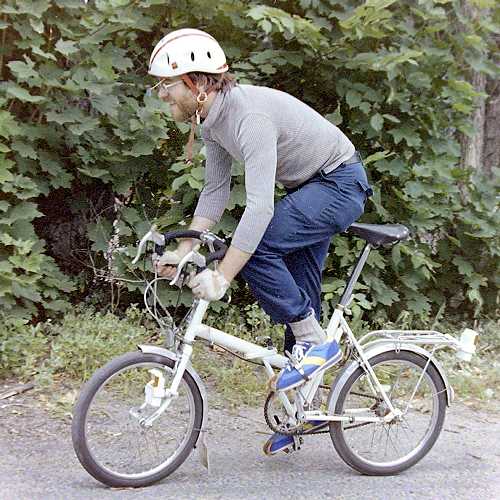 |
photo © 1979, Sheldon Brown |
| The Twenty is only available used these days. Twentys show up quite frequently on
EBay.
A stock Twenty has steel Raleigh components and a padded vinyl saddle, as shown in the photo below. You may also view an original owner's instruction sheet. But I customized my Twenty, as shown in the second photo below. |
A stock Twenty parked on a street in Philadelphia, summer of 2004
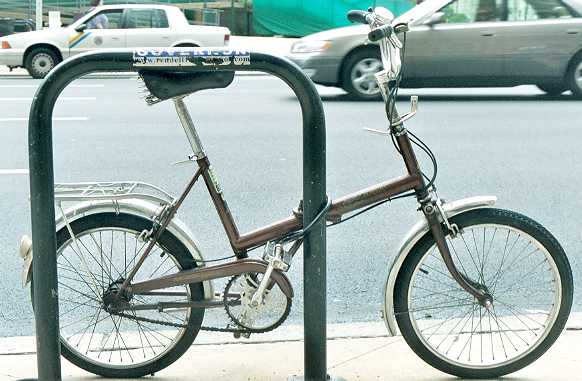 |
John S. Allen photo |
My Twenty in 1979, freshly customized --
no rear rack or handlebar tape yet.
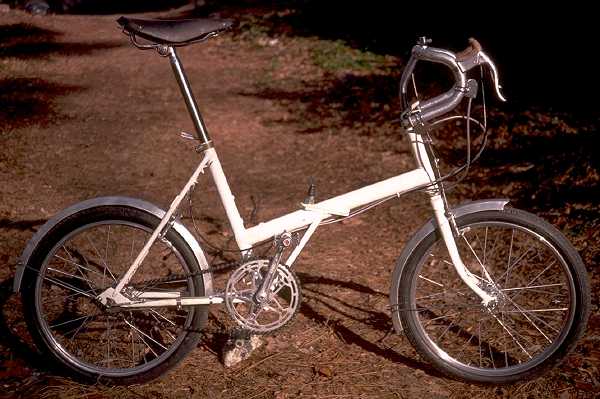 |
John S. Allen photo |
| My friend Sheldon Brown also is very much into Twenties and sheldonbrown.com has a Web page about
them. He found my Twenty at a flea market and sold it to me for $35. It then sported
an extended seatpost made from the seat tube another bicycle, a 3-foot high handlebar stem
crowned by an automotive steering wheel, and gold paint from a spray can. I can only begin
to imagine how it was used before Sheldon acquired it.
I ditched the odd components, brazed on brake bosses for Mafac centerpull brakes, had the frame sandblasted, and painted it with ugly but tough marine epoxy paint. I installed an aluminum crankset, aluminum rims, drop handlebars and a leather saddle. Having acquired a 26 TPI die from a bike shop that was closing, I threaded down the fork and replaced the nylon upper headset bearing with a stock Raleigh ball-bearing assembly. I geared a Sturmey-Archer 5-speed hub for a range of 36 to 81 inches (2.9 to 6.5 meters development). The internally-geared hub, able to downshift at a stop, is ideal for stop-and-go city riding. I took the above photo shortly after I assembled my Twenty in 1979. There is still no rear rack. I wasn't sure yet that the brake levers and shift levers were positioned correctly, so the handlebars aren't taped yet. I haven't even installed toe clips. The Twenty's low center of gravity and small wheels make it handle like a much lighter bicycle. Despite the wide tires, the rotational inertia is as low as with a racing bike, so the Twenty steers quickly. The small wheels make the Twenty 7 inches shorter overall than a conventional bicycle, and so it works its way through traffic jams very nicely. Despite the customization, my Twenty is heavier than other compact bicycles made today by Bike Friday, Brompton, Dahon and Moulton, yet the Twenty is by far my best bicycle for short to medium-distance commuting and errands.. Most years, I ride over a thousand miles on the Twenty. Using a cardboard box bungeed to the rear rack and a soft backpack, I can easily bring home 40 pounds of groceries on the Twenty. I can fold the Twenty, lock it around a parking meter post, and take the saddle, seatpost and hinge key, making the Twenty a very unattractive target for a thief. The Twenty is a bit large and heavy to fold and carry onto a commuter bus or urban rail car. I'd recommend a Bike Friday, Brompton or DaHon for that use. With the saddle down all the way and the handlebars draped over the frame, the Twenty does fit into the largest-size duffel bag commonly sold, and is fine for intercity bus and rail travel. The Twenty also can be checked as airline baggage and has traveled with me by air to all corners of the continental United States, and to Canada. But in its bag, it is prone to damage from rough airline baggage handling. The Bike Friday in its hard suitcase/trailer is the real deal for air travel. I hve owned a Bike Friday New World Tourist since 2005, but I still prefer the Twenty for utility trips. |
The Twenty folded and locked (1991), an unattractive target
for thieves.
Location: Logan Airport central parking garage. Never again to happen, sadly,
though hundreds of cars do still park there.
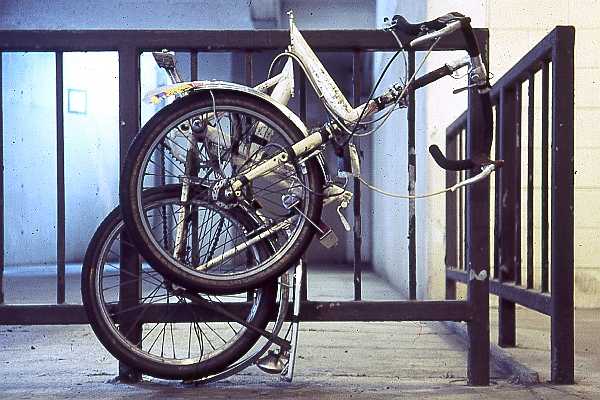 |
John S. Allen photo |
| After my 25 years of use, the Twenty is like George Washington's famous original ax --
the one which has had 23 new handles and 7 new bits. The only parts which remain from my
original customization are a few small fittings, the seatpost, brakes, front hub shell,
front spokes and most of the frame. Yet the Twenty still looks much as it did in 1979. Why
change something that works? After my crash in 1985, I couldn't find a stock Twenty fork, so I cut down a fork made for 27-inch wheels, and brazed in new dropouts. The new fork has less rake than the original one and the Twenty now tracks better around curves. In 1996, the right chainstay rusted out from inside and cracked. I rode home -- the non-derailleur chain held the broken ends of the chainstay together. I replaced both chainstays with others I cut from a trashed frame. The new chainstays are tapered, and stronger than the old ones. I made sure they drain well, to avoid a repeat of the rust problem. When I replaced the chainstays, I repainted the frame with the same marine epoxy enamel as before. Ugliness is a virtue in a city bicycle. I now use drop bars overturned and shortened at the ends so they don't strike my wrists. With the shorter stem, the handlebars flex much less than they used to. I will probably modify them again, since the ends of the bars are uncomfortable for my palms. The original Weinmann aluminum rims -- the first available in 20 x 1.75 size -- had become dented, and their narrow sidewalls made brake adjustments tricky. I replaced these rims with a new pair of Weinmanns, the kind that Burley uses on its trailers. The big Carradice saddlebag hardly affects the bike's handling since it is so near my center of gravity. I also use it on my touring bike: it can carry all the supplies for a weekend's tour, except the tent. I got this bag from Harris Cyclery, which also sells by mail order. I sometimes use a handlebar bag as well, as my "glove compartment", for tools, camera, snacks, cell phone and maps. |
The Twenty, April 30, 2005
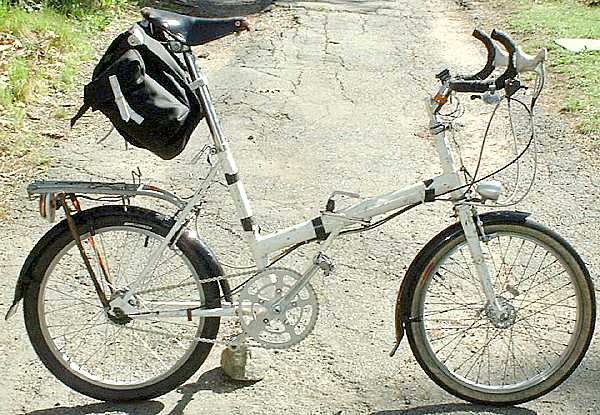 |
John S. Allen photo |
I originally equipped the Twenty with Ray-O-Vac clip-on lights powered by rechargeable flashlight batteries. Now I use generator lights, but I power them with a 6-volt gel-cell battery I keep in a side pocket of the saddlebag. The battery lets me use brighter bulbs than I could with a generator. A brazed-on generator bracket, original equipment on the replacement front fork, would easily let me switch over to a generator to use the Twenty where I couldn't expect to plug in my battery charger. The Twenty is now into its third Phil Wood bottom bracket and has been through over a dozen tires, chains and sprockets, four saddles and numerous brake shoes and cables. As I write this on May 7, 2005, I have recently returned from New York City, where I rode 45 miles last Sunday, including the 5-Boro Tour, and dozens of miles since. For my trip home, I stuffed the Twenty into its duffel at the Port Authority terminal and rode a Greyhound bus. When the bus let me off in Framingham, I reassembled the Twenty, bungeed my soft suitcase to the rear rack and rode the 9 miles home to Waltham. The Twenty still serves! [Update, September 2018: a 1" Aheadset top headset avoids the need for rethreading: see the page on sheldonbrown.com. I finally had to replace the frame, which had rusted out. The bicycle with the new frame is described here. For more about rust, rust prevention, and refinishing, see this page. I am using LED lights now. And -- I now have assembled a second Twenty with a Shimano Nexus 8-speed hub -- no page about that yet.] Twenty links (well, actually, only fourteen links):Original Raleigh Twenty instruction sheet Tony Hadlund's history of the Twenty Wikipedia page about the Twenty A modified Twenty packed into a suitcase like a Bike Friday Lenny Taylor's modified Twenty An unmodified but well-loved Twenty A gorgeous modified Twenty -- and links to many others! Guy Bouchard's very
modified Twenty (frame modifications too) |
| [Top: John S. Allen's
Home Page] [Up: Bicycling articles] [Previous] [Next: Tandem Crankset] |
Contents © 1999-2005 John S. Allen Last revised September 17, 2018 |